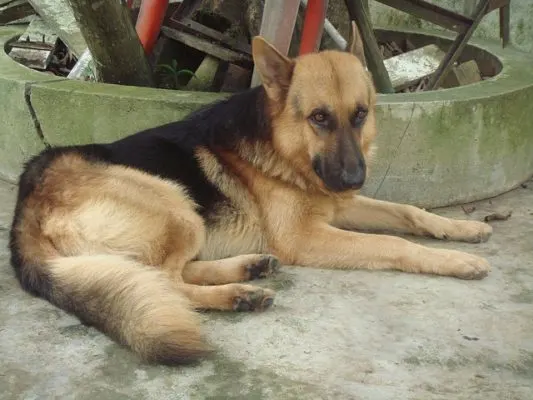Is the German Shepherd Bloodhound Mix a Great Trail Dog Choice?
The American Kennel Club has three words for the German Shepherd breed – confident, courageous, and smart.
An all-purpose worker, the GSD is one fine sniffing dog that the police often use. As for the bloodhound, it is known for its strong scent-tracking capability.
Combine them and just imagine what a trail dog you got!
The German Shepherd and Bloodhound breeds are known for one thing – tracking and finding people or things through scent.
If you need a great trail dog, the German Shepherd bloodhound mix is one great option. Their keen sense of smell can track and find things like no person or other dog breeds can.
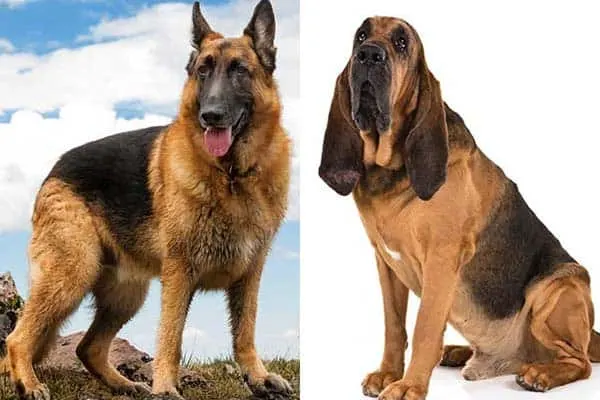
Getting to Know the Bloodhound Breed
The Bloodhound breed is a medium to large dog. It is known for its ability to track human scent from a distance according to Wikipedia.
From the Middle Ages to this day, Bloodhounds are used for tracking missing people, escaped prisoners, and even lost pets.
In a YouTube video uploaded by Cross Adventuring, it showed how Baxter, a Bloodhound tracked and located a missing person in 4.5 hours.
Among the known facts about Bloodhounds are as follows:
- An adult Bloodhound can weigh up to 160 pounds and can grow up to 27 inches or 69 centimeters
- It doesn’t rest until it finds the scent it is tracking, it is hard to control when it is tracking something
- It is affectionate for its size and very loving with humans, making it a great family pet
- Common colors of Bloodhound include black/tan, liver/tan, and red
- Bloodhounds have high risks of developing gastrointestinal ailments such as bloating, eye, ear, and skin infections, and overheating (because of their thick coat)
- A Bloodhound’s lifespan is up to 8 years
Getting to Know the German Shepherd Breed
The popular German Shepherd dog or GSD is a favorite among dog breeders. Dog Time describes it as an intelligent, highly capable, and courageous dog.
The GSD is not only trained for rescue operations, but it is also trained for searching, drug detection, and herding.
Among the known facts about German Shepherds are as follows:
- An adult German Shepherd can weigh up to 140 pounds and can grow up to 24 inches or 65 centimeters
- It is highly intelligent that it can learn a trick or follow instructions after five repetitions. The obedience rate of GSDs is 95%
- It is a very active dog with self-assurance in everything it does. It is curious and brave. It is an excellent guard dog that protects its pet parents and their properties
- Common colors of German Shepherds include black/tan, silver/tan, black, white/black
- German Shepherds have high risk of developing dysplasia or bone problems that affect their hip and elbow. It is also at risk of developing eye, ear, and skin infections. This dog breed is also at risk of developing Willebrand disease, an inherited bleeding disorder
- A German Shepherd’s lifespan is up to 13 years
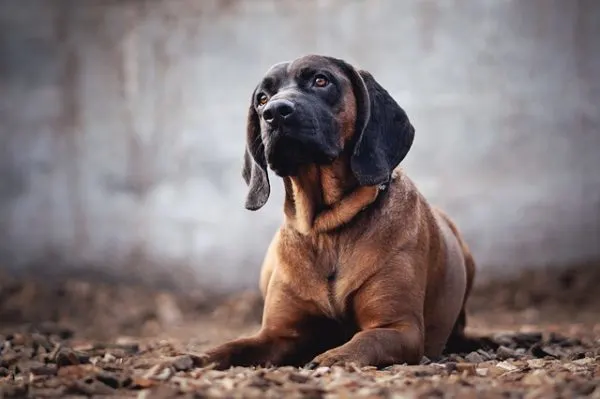
Getting to Know the German Shepherd Bloodhound Mix
The German Shepherd Bloodhound Mix is a cross of two big dogs – Bloodhound and GSD. There is not much information as to when this cross began.
Despite its lack of history, there are different dog owners who introduced their Bloodhound and GSD mix to the internet.
German Shepherd Lore introduces Buddy while DogsInDepth introduces Casanova.
Based on the information they provided, here are the known facts about the German Shepherd Bloodhound mix:
- An adult German Shepherd Bloodhound mix can weigh up to 160 pounds and can grow up to 27 inches or 69 centimeters
- It is highly intelligent with a keen sense of smell. It can track anything with its nose
- It is a very active dog but if given training at an early age, it can easily transform its energy into something positive
- Common colors of German Shepherd Bloodhound mix include black/tan, silver/tan, black, white/black, brown, red
- German Shepherd Bloodhound mix is at risk of developing dysplasia or bone problems. It is also at risk of developing eye, ear, and skin infections and gastro or bloating problem
- A German Shepherd Bloodhound mix lifespan is up to 13 years
In-Depth Understanding of the German Shepherd Bloodhound Mix
According to Reference.com, the German Shepherd Bloodhound mix is a known and existing breed.
However, as of 2014, this breed has not been officially recognized yet by any kennel association and doesn’t have an official name.
Limited information from this website described the German Shepherd Bloodhound mix as:
- Large cross-breed
- Black and tan in color
- With a strong sense of scent
- With incredible stamina
- A working-breed dog
- Trainable
Would It Be Good to Get A German Shepherd Bloodhound Mix?
With little to no information about this breed, it is best to get across that you are familiar with it. Also, it depends on why you want a German Shepherd Bloodhound mix.
If you want it because of its strong training and hunting capability, be advised that this wasn’t proven yet.
There are known German Shepherd Bloodhound mixes like Buddy and Casanova yet the capability of these dogs wasn’t tested.
What Breed to Have As An Alternative?
For an alternative breed to get, you have to consider two things – are you looking for a family pet or a guard dog?
If it is a family dog, the bloodhound line has a lot to offer. There are different bloodhound breeds such as the American English Coonhound, American Foxhound, and Basset Hound.
The charming, patient, and low-key Basset Hound is a winner among families who love to own a large dog-child.
AKC considers the Basset Hound as one of the most recognizable hound family pets in the world.
Besides, you can also get the very cute bloodhound-lab mix if you want to raise a large dog in your family.
The Happy Puppy Site considers the bloodhound-lab mix as one of the cutest mixes under the bloodhound line.
If you have an active lifestyle and you want a dog that can join you in your regular morning jobs and outdoor activities, the German Shepherd or its cross would be a great option.
Among the GSD crossbreeds that K9ofmine recommends are the popular Golden Shepherd (Golden Retriever and GSD mix) or the Siberian Shepherd (Siberian Husky and GSD mix).
These crosses produce medium to large size dogs and maintain the active, intelligent, and smart qualities of a GSD.
However, the purebred German Shepherd remains to be a great option if you are into medium to large size dogs.
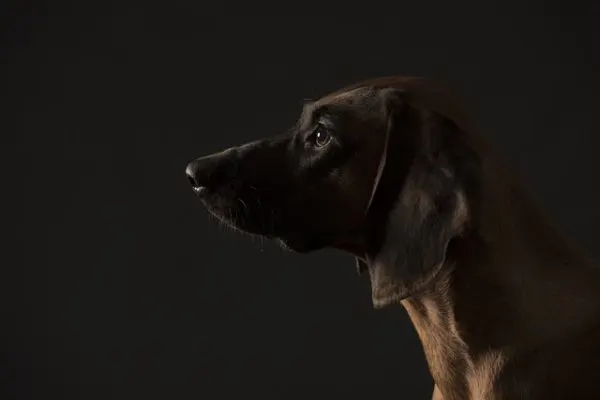
What to Consider When Choosing a Dog Breed?
Even with the limited information about the German Shepherd Bloodhound mix, you might still find some breeders that offer this cross-breed.
Before deciding on picking a German Shepherd Bloodhound mix, how about you consider these things first.
1. The temperament of the new breed – consider the parents of the new breed. What are their negative and positive temperaments? Remember that when breeding, there is no guarantee that the new breed will harness all the positive traits of the parents.
2. Size – are the parents medium to large dogs? Do you want a large dog or a smaller one? Do you have a place or space at home to confine a large dog?
3. Cost – what would you normally buy for your pet child? Aside from regular vaccines, vitamins, and regular vet check-ups, you also have to consider food, treats, grooming, and their toys among other accessories.
4. History – what do you know about the parents of the mix? Are they genetically free of diseases? What can your breeder tell you? Is it a known mix or a new one?
5. Health Condition – the health condition is often associated with the history of the new breed. Are the parents of the mix healthy? Say it is a GSD and a Bloodhound, is the GSD parent free of dysplasia? Is the Bloodhound parent free of ear, eyes, or skin infections?
6. Your Family – is your family ready to take on a new member? Does any member of the family have an allergy that a dog might trigger?
7. Your Lifestyle – taking home a dog means that the dog is your responsibility. Can you commit? Will it fit your lifestyle or will you make adjustments?
Choosing a dog breed is not all about the dog, it also talks about you, the future dog owner. You should choose a dog breed that can fit your lifestyle.
If you don’t love going out or you just spend your free time binge-watching Netflix, don’t get a German Shepherd
Do We See Any Future for the German Shepherd Bloodhound Mix?
The interest in the German Shepherd Bloodhound mix is low at the moment and it seems like breeders are more interested in breeding GSD with other breeds.
This is perhaps attributed to the fact that they are almost the same – these are already great herding and tracking dogs.
If you are into medium to large dogs, it is best to just consider a purebred GSD or any of the popular GSD mixes out there.
These existing breeds have been studied hence information about their temperament, grooming, food, and health conditions is already known, making it easier for pet owners to raise and train them well.
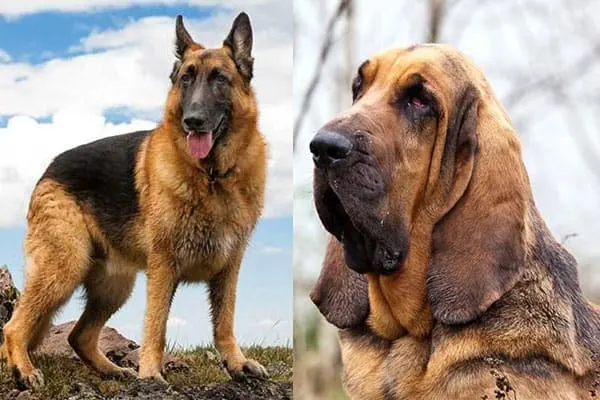
Frequently Asked Questions
How big will a Shepherd Hound Mix get?
A Shepherd Hound Mix will present characteristics of both parent breeds and depending on the ratio of the mix, how big these dogs will get can vary quite a lot.
For example, they will likely inherit a German Shepherd’s long body and a Basset Hounds’ short legs.
A German Shepherd Hound Mix will grow to small to medium height, typically measuring between around 12 inches and 20 inches.
Males tend to be larger on average than females, and it is possible for some to grow bigger than 20 inches.
In terms of weight, shepherd hound mixes can be as heavy as 50 to 70 pounds, but this can vary a lot depending on their height, how much they are fed and lifestyle, etc.
Do Hound dogs bark a lot?
Hound dogs do tend to bark a lot because that is how they tend to communicate. Barking is their natural reaction to a variety of situations, and they are not always barking because of something negative.
They produce a pretty distinctive ‘baying’ sound when they bark, predominantly because traditionally they were bred to howl as hunting dogs.
This distinctive bark can become quite disruptive, though, especially if your hound tends to bark more than normal.
There are ways to deter your hound dog from barking so much. It is possible that your hound dog is lonely, which is why they bark a lot when alone in the house or the yard at night.
Hound dogs are natural pack dogs, so socializing them will help.
If your hound dog is barking mainly due to boredom or lack of obedience, try taking them to an obedience class. This will also be a great way to socialize them and teach them to stop when told.
























